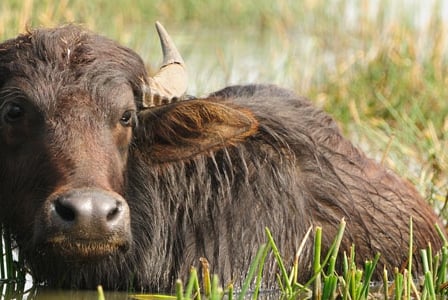
This Wildlife Wednesday, learn why there may be no purebred wild water buffalo left in the world.
Habitat: India and Asia
Water buffalo trivia
- Also called Asian buffalo, wild water buffalo can weigh up to 1,000 kg. It’s their size that acts as their defence, because they pose quite a challenge to predators. The only animal that typically attempts to take down a water buffalo is the tiger, and even this can be a very difficult feat.
- Not surprisingly, water buffalo can be found hanging out around (and in) the water. This helps cool them down, and also protects them from pesky flies.
- Although they may look similar, water buffalo should not be confused with African buffalo, which are not thought to be closely related.
- Both males and females grow horns but females’ horns are smaller.
- Water buffalo have been domesticated for more than 5,000 years. Because wild water buffalo come into contact with feral and domestic water buffalo and can interbreed, it’s possible that there are no true, purebred wild buffalo remaining.
- In Asia, domestic water buffalo are used in agriculture so commonly that they are referred to as the “living tractor of the East.”
Why they’re threatened
Water buffalo are endangered. There are fewer than 4,000 animals left in the wild, and the population is expected to decrease by half within the next three generations. Threats include hunting for their horns, as well as loss of habitat due to agriculture, commercial development, and roads. Wild water buffalo are also at risk of catching diseases from domestic animals. Many populations are protected by law, and conservation work is being done to help protect these amazing animals.

















